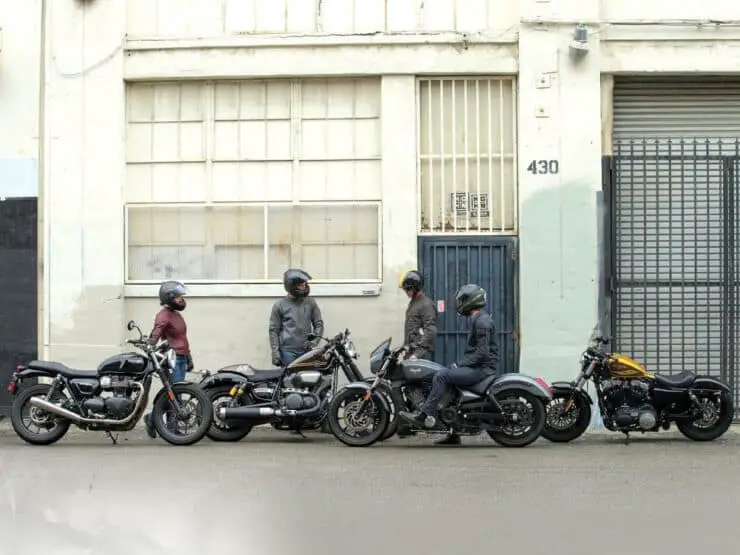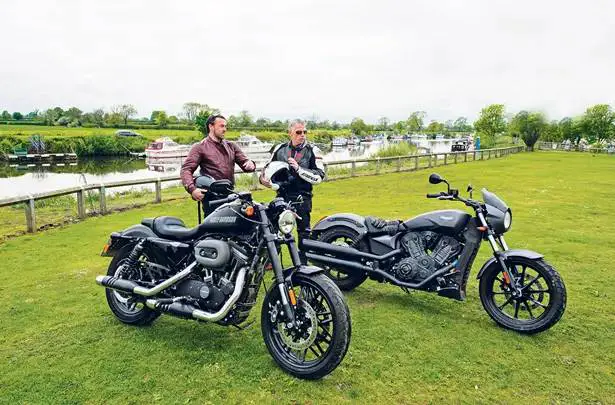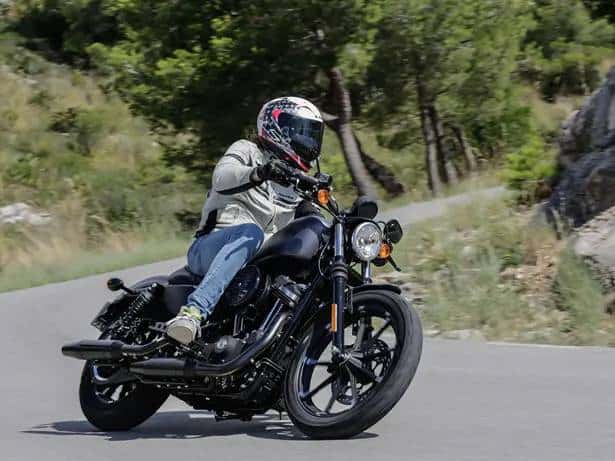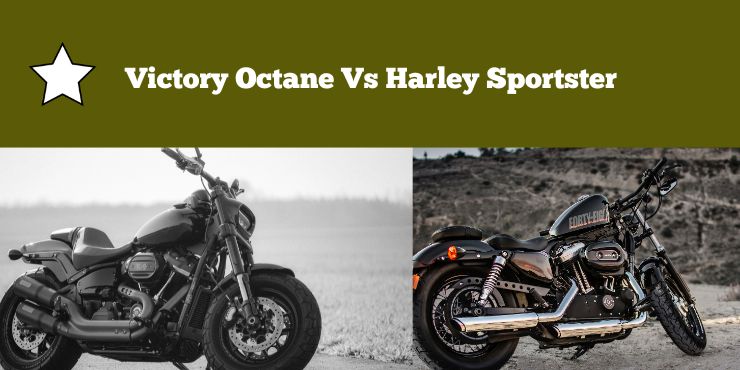Are you in the market for a new motorcycle? Do you find yourself torn between the Victory Octane and the Harley Sportster?
The Victory Octane is known for its liquid-cooled engine and sportier design, offering higher horsepower. The Harley Sportster emphasizes classic styling and cruiser comfort with an air-cooled V-twin engine, appealing to traditional cruiser enthusiasts.
This article will provide a comprehensive comparison of these two popular motorcycles and help you make the best decision for your needs. From performance to price, we’ll explore the differences between these two models and help you decide which motorcycle is the best fit for you. So, buckle up and get ready to dive into the Victory Octane vs. Harley Sportster debate!
History of Victory Octane
The Victory Octane is a powerful and stylish bike that holds a special place in the hearts of motorcycle enthusiasts. Born from the vision of the now-defunct American motorcycle manufacturer Victory Motorcycles, the Victory Octane was a testament to the company’s commitment to innovation, performance, and distinctive design. Throughout its brief but impactful existence, the bike left an indelible mark on the motorcycle industry, captivating bikers with its blend of power, agility, and unmatched aesthetics.
Victory Motorcycles emerged on the scene in 1998, backed by Polaris Industries, a renowned manufacturer of powersports vehicles. Positioned as a direct competitor to motorcycle giant Harley-Davidson, Victory Motorcycles aimed to offer a unique alternative for bikers looking for American-made bikes with a modern twist.
In 2016, Victory Motorcycles unveiled the Octane to the world. This sleek and muscular cruiser presented a departure from the traditional design language typically associated with American bikes. The Victory Octane embodied a more aggressive and sporty stance, which appealed to a younger and more performance-oriented audience.
At the heart of the Victory Octane is a 1,179cc liquid-cooled V-twin engine. This powerhouse produced an impressive 104 HP and 76 lb-ft of torque as it delivers huge acceleration and a thrilling riding experience. The lightweight chassis and carefully tuned suspension will provide excellent handling and maneuverability, making the Octane a true joy to ride on city streets and winding country roads.
The Octane’s design was an amalgamation of classic cruiser aesthetics and modern styling cues. Its streamlined body comes with clean lines, a sculpted tank, and a low-slung profile, exuding an aura of confidence and aggression. The minimalist approach extended to the cockpit, with a single record gauge housing the important info, further emphasizing the bike’s no-nonsense attitude.
Despite the promising start, Victory Motorcycles faced challenges in an extremely competitive market. In 2017, Polaris Industries made the decision to discontinue the Victory Motorcycles brand, including the Octane due to ongoing financial constraints. This move was aimed at refocusing resources on their other brand, Indian Motorcycle.

History of Harley-Davidson Sportster
The Harley-Davidson Sportster is an iconic motorcycle that has left quite a mark on the motorcycle industry. Renowned for its raw power, distinctive style, and enduring legacy, the Sportster has managed to captivate bikers for more than six decades. From its humble beginnings as a lightweight and agile racing motorcycle to its transformation into a symbol of rebellion and freedom, the Sportster’s history is a testament to the enduring spirit of Harley-Davidson.
In 1957, Harley introduced the Sportster as a response to the growing demand for smaller, more nimble bikes. The bike was initially conceived as a racing model designed for competing in the emerging world of dirt track racing. Its lightweight frame, telescopic front forks, and powerful engine made it an instant favorite among bikers. It perfectly showcased Harley-Davidson’s commitment to performance.
Over the years, the Harley-Davidson Sportster underwent significant design and performance enhancements. In the 60s, Harley-Davidson introduced the iconic “Ironhead” engine characterized by its overhead valve configuration and distinctive appearance. This engine delivered improved power and torque, solidifying the bike’s reputation as a force to be reckoned with on the road and on the racetrack.
In the 80s, the Sportster underwent a major transformation with the introduction of the Evolution engine. This new powerplant boasted improved reliability, increased power output, and reduced vibration. The Evolution engine helped propel the Sportster into the modern era and solidified its place as one of the most popular bikes in the Harley-Davidson lineup.
Beyond its mechanical prowess, the Sportster also played a key role in the motorcycle culture. In the 50s and 60s, it became a symbol of rebellion, associated with motorcycle clubs and counterculture movements. The Sportster’s compact size and accessible price point made it a popular choice for bikers looking for individuality and a sense of freedom on the open road.
One of the defining features of the Sportster is its adaptability and customizability. Its modular design and a wide array of aftermarket parts have allowed bikers to personalize their Sportster to suit their individual tastes and riding preferences. From bobbers to café racers, choppers to scrambles, the Sportster has served as a canvas for countless custom motorcycle builders, further enhancing its legendary status.
The Harley-Davidson Sportster has managed to stand the test of time and still remains a beloved bike among riders of all generations. Its enduring legacy can be seen in the continued production of Sportster models today. While the design and technology might have evolved, the spirit and essence of the original Sportster still shine through.

Similarities and differences in the design between Victory Octane and Harley-Davidson Sportster
The Victory Octane and the Harley-Davidson Sportster are two legendary bikes that have left an inedible mark on the industry. Both models showcase performance, American craftsmanship, and a distinctive aesthetic. While each bike comes with its unique design language, comparing the similarities and differences between the Victory Octane and the Harley-Davidson Softail will help you find out more about their designs.
The similarities between the Victory Octane and the Harley-Davidson Softail are –
#1. Cruiser styling
Both the Victory Octane and the Harley-Davidson Sportster belong to the cruiser category, embodying the classic American motorcycle aesthetic. They share design elements like low-slung profiles, long wheelbases, and a relaxed riding position that gives an aura of power and comfort.
#2. V-twin engines
The heart of both these bikes beats with a V-twin engine, which is the hallmark of American motorcycles. While the specific engine configurations differ, the characteristic rumble and performance capabilities are shared between the Octane and the Sportster.
#3. Minimalist cockpit
Both these bikes embrace a minimalist approach in the cockpit design. The instrument clusters are largely limited to essential information, often featuring a single round gauge. This allows the biker to focus on the road ahead. This simplicity enhances the overall clean and uncluttered appearance.
The differences between the Victory Octane and the Harley-Davidson Softail are –
#1. Stylistic approach
The Victory Octane embraces a more aggressive and contemporary design compared to the Sportster. The Octave features clean lines, sharp angles, and a streamlined body while the Sportster retains a more traditional and nostalgic look, with round headlamps, chrome accents, and heritage-inspired design cues.
#2. Bodywork and finishing
The Victory Octane showcases a more muscular and sculpted bodywork. This is accentuated by bold fuel tank contours and sharp rear fenders. Meanwhile, the Harley-Davidson Sportster often features flowing lines and more extensive use of chrome finishes, contributing to its timeless appeal and classic cruiser charm.
#3. Frame and suspension
The Victory Octane utilizes a lightweight frame and advanced suspension technology to offer enhanced maneuverability and agility. Harley-Davidson Sportster, on the other hand, typically features a sturdier frame, emphasizing stability and a smooth ride.
#4. Customization culture
While both bikes are decent options for customization, the Harley-Davidson Sportster has a long-standing and vibrant custom culture associated with it.
The Sportster’s modular design and vast aftermarket support make it a great canvas for bikers and custom builders to create unique and personalized machines. The Victory Octane might be customizable but it doesn’t have the same level of dedicated custom parts and accessory market.
Victory Octane vs Harley Sportster Comparison: Performance
Both Victory Octane and Harley-Davidson Sportster come with distinctive characteristics and legacies. While both bikes belong to the cruiser category, they are notable differences in engine, and transmission design, acceleration, and power output. Understanding these variations will help provide valuable insights into the performance capabilities of the two bikes.
Engine and transmission
The Victory Octane and the Harley-Davidson Sportster make use of the V-twin engine but they make use of different engine configurations and transmission systems. This results in varying performance characteristics.
The Victory Octane comes with a liquid-cooled 1,179cc V-twin engine. It delivers impressive power and torque, generating almost 104 HP and 76 lb-ft of torque. The liquid-cooling system will help maintain optimal engine temperature, enhancing performance, and reliability. The Octane also comes equipped with six-speed constant mesh transmission, offering smooth gear transitions and optimal power delivery.
The Harley-Davidson Sportster lineup consists of various models, each with its own engine configuration. The most popular engine option is the air-cooled 1,200cc Evolution V-twin engine. The power output of the Harley-Davidson Sportster varies between models but it typically produces around 70-80 HP and 70-80 lb-ft of torque. The Sportster typically makes use of a five-speed constant mesh transmission, providing riders with a traditional shifting experience.
Power output
The output of the bike’s engine directly influences its performance capabilities and overall riding experience. With the larger engine displacement and liquid-cooled design, the Victory Octane delivers robust power and acceleration. The 104 HP generated by the Octane allows for swift overtakes, dynamic acceleration, and a thrilling riding experience.
While the power output of the Sportster varies across models, the 1,200cc Evolution engine delivers substantial power within the displacement class. With 70-80 HP, the Sportster offers strong and responsive performance, ensuring an enjoyable ride.
Acceleration
Acceleration is an important aspect of motorcycle performance, determining how quickly a motorcycle can reach higher speeds. The Victory Octane’s powerful engine and optimized power-to-weight ratio contribute greatly to its impressive acceleration. The Octane can easily go from 0 mph to 60 mph in under 4 seconds, allowing the bikers to experience thrilling bursts of speed and rapid acceleration.
The Sportster’s acceleration varies depending on the model and engine configuration. On average, the Sportster is able to achieve 0 to 60 mph in approximately 4.5 to 5.5 seconds. While slower than the Octane, the Sportster still delivers solid acceleration, ensuring an exhilarating riding experience.
Victory Octane vs Harley Sportster Comparison: Handling and ride quality
When it comes to motorcycles, there are certain factors that play a key role in determining the overall riding experience. In the case of the Victory Octane and the Harley-Davidson Sportster, there are many differences. Here are the differences in terms of handling and ride quality, offering insights into the distinct characteristics and capabilities of these iconic bikes.
Suspension
The suspension system of a bike affects its ability to absorb bumps, provide stability, and ensure a comfortable ride. The Victory Octane comes with a well-tuned suspension system, combining a traditional front telescoping fork with rear mono-shock. This setup offers the right balance between comfort and handling, allowing the Victory Octane to glide smoothly over various road surfaces. The suspension system’s adjustability ensures bikers can tailor the ride quality to their preferences.
Meanwhile, the Harley-Davidson Sportster’s suspension varies across different models but it commonly incorporates a front telescopic fork and dual rear shock absorbers. The Sportster’s suspension tends to prioritize comfort, offering a plush ride that excels on long, straight stretches of road. However, the Sportster’s suspension might exhibit some limitations when it comes to aggressive cornering or high-performance maneuvers.
Brakes
The braking system is important for safety and control, particularly during rapid deceleration or emergency stops. The Victory Octane features a reliable braking system, typically equipped with dual disc brakes at the front and a single disc brake at the rear. This setup can deliver strong and consistent stopping power, allowing the bikers to confidently control the Octane in various riding situations.
Harley-Davidson Sportsters, on the other hand, come equipped with single-disc brakes, both at the front and the rear. While these brakes offer sufficient stopping power, the Sportster’s braking system might require a slightly higher input effort compared to the Octane’s setup.
Handling
Handling refers to the bike’s agility, responsiveness, and ease of maneuvering, which contributes significantly to the riding experience. Victory Octane comes with impressive handling capabilities. Its lightweight chassis, well-balanced weight distribution, and responsive suspension will enable precise cornering, nimble navigation through traffic, and enjoyable overall maneuverability. The Octane’s sporty design and performance-oriented characteristics make it a rather capable machine on twisty roads.
The Harley-Davidson Sportster’s handling is more relaxed and stable. Its design favors a comfortable cruising experience, which makes it suitable for longer rides and highway cruising. While the Sportster might not offer the same level of agility as the Octane, it still offers a confident and enjoyable ride, especially during leisurely cruising and relaxed journeys.

Victory Octane vs Harley Sportster Comparison: Comfort and Ergonomics
Comfort and ergonomics are important consideration for motorcycle riders, especially during long rides or extended periods of time on the road. The Victory Octane and the Harley-Davidson Sportster are two iconic bikes that feature distinctive designs and ergonomics that cater to different preferences. Examining the differences in comfort and ergonomics will give you a better insight into the two bikes.
Seat design
The design and construction of the motorcycle seat play a key role in rider comfort, especially during extended rides. The Victory Octane typically comes with a low-profile solo seat. These seats are designed for providing a sporty and streamlined appearance while allowing the rider to maintain a lower center of gravity. While the seat might be less padded compared to some other models, it still offers a more aggressive riding position that suits riders looking for a dynamic and engaged experience.
Meanwhile, the Harley-Davidson Sportster offers a wide range of seat options, including solo seats, two-up seats, and seats with additional padding for enhanced comfort. The seats are typically wider and more cushioned, prioritizing long-distance comfort and support. These seats allow riders to settle into a relaxed riding position, reducing fatigue during extended rides.
Foot controls
The placement and design of foot controls will affect rider comfort and ergonomics by providing a natural and relaxed riding position. The Victory Octane typically features mid-mounted foot controls, positioning the rider’s feet closer to the center of the bike. This setup offers a more sporty and aggressive riding position, providing riders with a better sense of control and maneuverability.
The Harley-Davidson Sportster’s foot controls are usually positioned forward, allowing the riders to stretch their legs and assume a more laid-back riding position. This configuration will provide a comfortable and relaxed posture for long-distance cruising and emphasizes rider comfort.
Handlebars
The handlebar design will greatly influence rider posture, upper body positioning, and overall control of the bike. The Victory Octane comes with drag-style handlebars. These low, flat, and forward-mounted handlebars encourage an aggressive riding position and facilitate a more engaged and dynamic riding experience. The position of the handlebars here promotes an aerodynamic posture while offering a sporty and responsive feel.
For Harley-Davidson Sportsters, the handlebars feature a variety of handlebar options. Many Sportster models come with pullback handlebars that are slightly raised and swept back towards the rider. This configuration will promote a more upright and relaxed riding position, reducing strain on the back and shoulders. The pullback handlebars will give you a comfortable grip and contribute to a laid-back cruising experience.
Victory Octane vs Harley Sportster comparison: Price and value
When you are thinking of purchasing a new bike, the price plays a significant role in your decision-making process. The Victory Octane and Harley-Davidson Sportster are renowned models in the cruiser segment and they offer distinct price points and perceived value. Understanding the difference between their price and value will help you make a well-informed decision based on your budget and desired features.
Here is how the Victory Octane and the Harley-Davidson Sportster differ in terms of price comparison –
The Victory Octane was introduced as a versatile mid-range cruiser bike in the Victory lineup. While the pricing varied based on factors like location and optional features, the Octane generally falls within an affordable price range compared to other cruiser models. Its price point positioned it as a highly attractive option for bikers looking for a performance-oriented cruiser without breaking the bank. It is worth mentioning that the Victory Octane has been discontinued, so the bike will only be available in the used motorcycle segment.
Meanwhile, the Harley-Davidson Sportster lineup encompasses various models, each with its own price range The Sportster carries a higher price tag compared to the Victory Octane. The price variations can be attributed to factors like model year, engine size, and optional accessories. Harley-Davidson’s brand prestige and associated cost of ownership will contribute to Sportster’s higher price point.
Here is how the Victory Octane and the Harley-Davidson Sportster compare in terms of perceived value –
The Victory Octane offers great value for its price. It comes with a powerful engine, modern styling, and a performance-oriented focus. With its comfortable ergonomics, aggressive design, and competitive pricing, the Octane delivers a compelling package that appeals to riders looking for an affordable cruiser without compromising on style and performance.
Harley’s Sportster carries a strong brand reputation and heritage. The Sportster line is synonymous with the Harley-Davidson legacy and has a loyal following of enthusiasts. This brand value contributes to the perceived value of the Sportster models. Owners of the Harley-Davidson bikes often appreciate the sense of community, extensive customization options, and long-term resale value associated with the brand.
Also read: 2020 Honda Goldwing vs. Harley-Davidson Ultra Limited
FAQs
What is the main difference between a Victory Octane and a Harley Sportster?
The Victory Octane and Harley Sportster are two popular motorcycles with distinct features and performance capabilities. The Victory Octane is a sporty and aggressive-looking bike with a powerful V-Twin engine and advanced suspension, while the Harley Sportster is a classic cruiser-style bike with a smooth and comfortable ride.
What are the advantages and disadvantages of each bike?
The Victory Octane has a powerful engine and advanced suspension, making it great for performance riding and aggressive cornering. However, it may be too powerful for some riders and its fuel economy may not be as good as other bikes. The Harley Sportster is a classic cruiser-style bike with a smooth and comfortable ride, but it may lack the power and agility of other bikes.
Which bike is better for long distance riding?
The Harley Sportster is the better choice for long distance riding due to its comfortable ride and classic cruiser style. The Victory Octane may be too powerful for long distance rides and its aggressive riding style may not be suitable for long rides.

